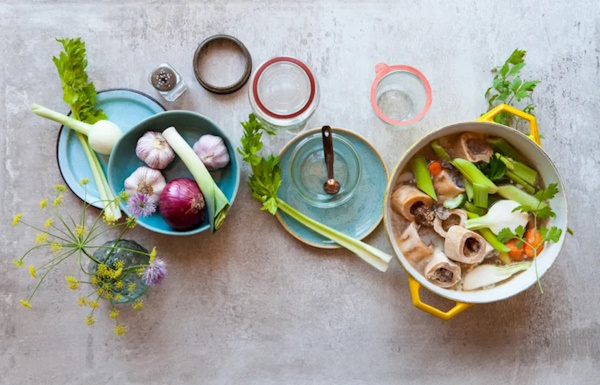
Stock your kitchen with these nutritionist-recommended foods that will nourish and heal your body from within.
ByTiffany Tse
Ready to drown out the noise on the latest superfood fads and start eating the stuff that truly helps heal your body from within? We went straight to the experts to curate a science-based selection of great-for-you foods proven to actually improve your overall health.
In a world where there’s a new, trendy superfood backed by overhyped promises, discerning what’s actually good for you can be challenging. That’s where we step in. Instead of chasing fleeting food fads, we sought out experts who set the record straight on the world’s best healing foods. From a tasty fruit that could help expedite the wound healing process to fiber-rich seeds that might be the key to alleviating menstrual pains, we’ve rounded up a list of science-backed, expert-endorsed foods with proven benefits for your health. No, these aren’t magical cures for all of your ailments, but when consumed wisely, these delicious and sensible additions to your diet will work wonders to enhance your overall well-being.
Keep reading for nine foods you should add to your cart the next time you’re grocery shopping.
1. Sauerkraut
A crunchy fermented cabbage with roots in central Europe, sauerkraut is considered a national dish in Germany — with a name that directly translates to “acid cabbage.” The Encyclopedia of Agriculture and Food Systems describes how, in many parts of southern Germany, some families would feed raw sauerkraut to their children twice a week, as it was believed to support and strengthen their intestines. Clearly, they were onto something.
“It’s nothing short of a wonder for our digestive health,” explains celebrity nutrition expert and New York Times bestselling author Kellyann Petrucci, ND, a naturopathic physician. “It’s a robust source of Lactobacillus bacteria. These beneficial microorganisms are instrumental in fostering a gut environment that’s both balanced and thriving.”
A review of sauerkraut published in the International Journal of Food Properties in October 2022 made the case that Lactobacillus bacteria could help with diarrhea, constipation, irritable bowel syndrome, as well as other digestive issues. But that’s not at all. According to the U.S. Department of Agriculture (USDA) food database, a cup of sauerkraut (undrained) has almost seven grams of fiber — or about 25 percent of the daily recommended value — making this food a digestive-health powerhouse.
2. Turmeric
If you don’t already have turmeric in your spice rack, now’s the perfect time to add this vibrant, golden-orange spice to your kitchen. Curcumin, the biologically active compound found in turmeric, is excellent at combating tension and lowering inflammation.
“Chronic tension can be a silent underminer of health, weakening the immune system over time,” says Dr. Petrucci. “Turmeric, with its curcumin content, disrupts this cycle, restoring the immune system’s balance.”
A study of curcumin published in CNS Drugs in February 2022 looked at both animal and human trials to support the efficacy of curcumin as a possible treatment for depression. When curcumin was administered in adults with clinical depression, it was more effective than a placebo in reducing depression and anxiety symptoms.
Why? As suggested by an earlier study, it might be because curcumin supplementation increases serotonin, also known as the “happy” chemical that’s responsible for controlling your mood and emotions. So the next time you are feeling stressed or anxious, try brewing turmeric tea or seasoning your veggies with it and let this spice work its magic.
3. Bone Broth
Made from boiling down animal bones and connective tissue, bone broth has been hailed as a superfood for years — and for very good reason. “Collagen protein is in cuts of meat full of connective tissue, like pot roast, brisket, and chuck steak,” says Petrucci. “Bone broth has emerged as a superior whole food source of collagen because it’s lower in calories and saturated fats compared to other sources. I like to think of collagen as Spanx for the face because without it, your skin would fall right off your bones.”
Drinking bone broth helps to replenish collagen, which, according to a systematic review of 11 studies published in the Journal of Drugs in Dermatology in January 2019, assists in increasing skin elasticity and hydration as well as reducing wrinkles. Plus, a report published in Nutrients in March 2023 found that specific types and structures of collagen can be highly beneficial in reducing inflammation and protecting joints.
But simmering your broth for only a few hours won’t cut it. According to Petrucci, bone broth derives all of its nutritional benefits from its slow-cooking process, usually upwards of 24 hours. “It’s in that process that the vital nutrients are extracted from the bones,” she says. “While stock has some health benefits, it doesn’t hold a candle to bone broth’s nutritional density.”
4. Ground Flaxseed
Women who experience the pain of menstrual cramps know just how agonizing they can be. Tiny but mighty flaxseed could hold the key to relief, according to functional nutritionist Shannon Sokolow.
“Flaxseed contains something called phytoestrogenic lignans, which help balance hormone metabolism and block the negative effects of excess estrogens, which can cause PMS symptoms,” she says. “The seeds are like little powerhouses of fiber that can actually help reduce estrogen levels.” Estrogen thickens the uterine lining, which breaks down during the menstrual cycle, leading to cramps, abdominal pain, and other uncomfortable period symptoms. However, the lignans found in flaxseed support hormone balance by binding to estrogen and aiding in its removal through bowel movements.
In addition to boasting a high lignan content, flaxseed also serves as a plentiful source of heart-healthy omega-3 fatty acids — which can also help reduce the intensity of period pain. When that time of month approaches, consider incorporating the seeds into your oatmeal, smoothies, or yogurt for a little relief.
5. Acerola Cherries
Got a cut, scrape, or a scratch? Of all the fruits that heal wounds, acerola cherries — also known as Barbados cherries (which, despite their name, aren’t true cherries) — are miracle workers. Typically found in health food stores or farmers’ markets, these small, tangy, cherry-like berries are also available in powder, capsule, or juice-blend form.
While most berries (blueberries, strawberries, blackberries, raspberries, etc.) are packed with health benefits, a study published in the Journal of Food Science and Technology in September 2018 found that acerola cherries contain an exorbitant amount of ascorbic acid, or vitamin C, which is critical for healing wounds. And a review published in 2016 in the International Journal of Surgery Open reported that treating patients with ascorbic acid supplementation could rapidly improve their wound healing process post-surgery.
“Having adequate levels of vitamin C is crucial for strengthening the healing wound,” says Sokolow. “Vitamin C plays a vital role in the synthesis of collagen, the binding together of collagen fibers, and the formation of new blood vessels,.”
Tart, sweet acerola cherries have 916 percent of the DV (daily value) for vitamin C, or around 50 to 100 times more than that of an orange or lemon — so eat up and let the healing begin.
6. Leeks
If you need to improve your gut health, chances are you already have several foods in your kitchen that might help with digestion and nutrient absorption. An allium vegetable in the same family as onions, garlic, and chives, leeks are a robust source of good-for-you prebiotics. You may have heard of probiotics, but prebiotics also play an essential role in gut health. While the former adds more healthy bacteria to your microbiome, the latter helps good bacteria grow.
“Prebiotics differ from probiotic-rich foods in that they are a dietary fiber that the body cannot digest, so in turn they feed the beneficial bacteria living in our gut and help them stay alive and grow,” says Sokolow. “It’s the number-one food I recommend to my clients to make sure they incorporate in their diet daily.”
A study published in the journal Foods in March 2019 determined that prebiotics can restore the balance of microorganisms in your gut, making it stronger and healthier and helping to keep disease and illness at bay. So it’s high time for underappreciated leeks to get a little more attention at the dinner table.
7. Wild-Caught Salmon
Wild-caught salmon is one of the top foods that help heal colon inflammation, thanks to its abundance of omega-3 fatty acids. The fish provides EPA and DHA, two of the three primary types of omega-3s, which are difficult to acquire through the conversion of the more commonly found ALA.
Since your body can’t produce these essential fats from scratch, the only way to get your fix is by incorporating foods like salmon and other fatty fish into your diet. “These fatty acids are highly anti-inflammatory and really beneficial for lowering the inflammatory response in the body,” says Sokolow. “It’s especially important for the health of cell membranes, which can impact the body’s ability to regulate inflammation.”
Acoording to a study published in Scandinavian Journal of Clinical and Laboratory Investigation in February 2011, a diet rich in salmon benefited patients with active ulcerative colitis, an inflammatory bowel disease. But the advantages don’t stop there: Salmon and other fatty fish can also be effective against various other inflammatory conditions, including arthritis. Research has indicated that a higher fish intake is associated with reduced disease activity in rheumatoid arthritis.
8. Garlic
Ever hear the myth about vampires and their aversion to garlic? Medieval Europeans believed that vampires were created by a disease of the blood, so people carried garlic in hopes that its healing antibiotic powers would be able to ward off their local Dracula. Turns out they weren’t wrong about garlic. In the same allium family as leeks, fresh garlic contains a potent chemical compound called allicin. But beyond just lending garlic its distinctive pungent odor, the all-star compound also has antimicrobial, antifungal, and antiseptic properties.
“Allicin is released when a garlic clove is crushed, smashed, or chopped, and it can boost your immune system and help fight off cold-causing viruses,” explains Sokolow. A study published in the journal Antioxidants in July 2020 offered a comprehensive review on garlic’s health-promoting effects, suggesting that it reduced the severity of colds and flu in addition to improving inflammation.
9. Canned Sardines
If you’ve ever experienced the pain and inconvenience of a fractured or broken bone, you know that accelerating the healing process is paramount. Enter: canned sardines, which are full of soft, small, edible bones that help boost your calcium intake.
In fact, a 3.75-ounce can of sardines contains even more calcium than an 8-ounce glass of whole milk. “They’re packed with all the essential nutrients for bone healing,” says Sokolow. “They have great protein content, omega-3s, and a highly absorbable form of calcium, which is crucial for bone health.” Not only do these small silver swimmers speed up the healing process, but they may also help reduce the risk of fractures, as demonstrated in a study published in 2017 in the Journal of Osteoporosis that consuming fish at least once a week is associated with a 33 percent reduced risk of hip fracture.




